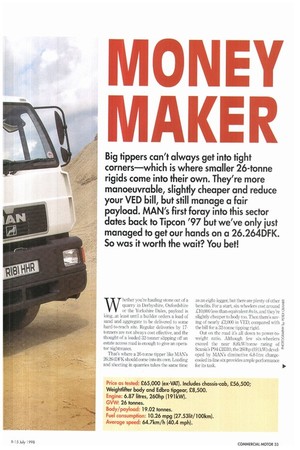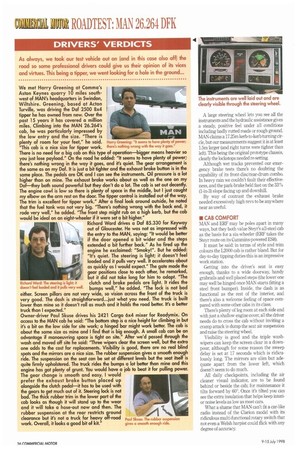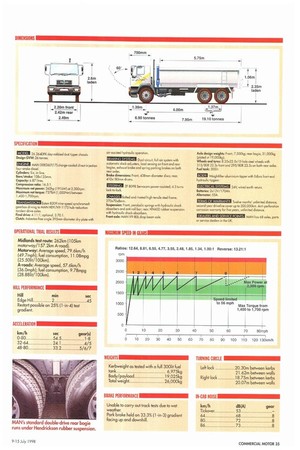IJJJI ROADTEST: MAN 26264 DFK
Page 34

Page 35

Page 36

Page 38

Page 39

Page 37

If you've noticed an error in this article please click here to report it so we can fix it.
Big tippers can't always get into tight corners—which is where smaller 26-tonne rigids come into their own. They're more manoeuvrable, slightly cheaper and reduce your VED bill, but still manage a fair payload. MAN's first foray into this sector dates back to Tipcon '97 but we've only just managed to get our hands on a 26.264DFK. So was it worth the wait? You bet!
Whether you're hauling stone out of a quarry in Derbyshire, Oxfordshire or the Yorkshire Dales, payload is king...at least until a builder orders a load of sand and aggregate to be delivered to some hard-to-reach site. Regular deliveries by 17tonners are not always cost effective, and the thought of a loaded 32-tonner slipping off an estate access road is enough to give an operator nightmares.
That's where a 26-tonne tipper like MAN's 26.264DFK should come into its own. Loading and sheeting in quarries takes the same time
as an eight-legger, but there are plenty of other a5 benefits. For a start, six-wheelers cost around £10,000 less than equivalent 8x4s, and they're slightly cheaper to body too. Then there's saying of nearly £2,000 in VED, compared with
the bill for a 32-tonne tipping rigid.
Out on the road it's all down to power-toB. weight ratio. Although few six-wheelers 8
>
exceed the near 8.8kW/tonne rating of 'g Scania's P94 CB310, the 260hp (191kW) deyeloped by MAN's diminutive 6.8-litre chargecooled in-line six provides ample performance for its task.
Anyone curious about MAN's motives for producing this competitive six-legger should note that while most of the 1,800 eight-leggers sold last year became tippers, around 650 three-axled trucks also joined the sector. That pattern shows no sign of changing this year.
Obviously there are plenty of tippermen and mixer operators who want to keep sixwheelers available for customers needing slightly smaller loads, so MAN can only benefit from taking its 26.264DFK to the party.
• PRODUCT PROFILE It's just over a year since MAN's new 26-tonner graced TipCon's show at Harrogate with a promise of deliveries by early 1998 (CM17-23 April 1997). That target did slip somewhat, but several are now in service with customers such as Savage Brothers in Northern Ireland and South Coast operator TJ Transport. By the end of this month English China Clay will have nine in its fleet.
There's little change to MAN's original specification: it's based on an M2000 17-tonner but with extra flitching on the chassis and a standard double-drive rear bogie slung under Hendrickson's HN402 rubber suspension. But it does feature the smaller and lighter Steyr-sourced L-type cab in place of the standard F2000 eight-legger's cab.
The 26.264DFK's driveline is pretty familiar, from the 260hp (191kVV) charge-cooled 6.87-litre diesel to Eaton's direct-top ninespeed synchromesh gearbox. The drive is transmitted via a 395mm-diameter single dry plate clutch (instead of the 8x4's 430mm set-up). The standard 4.11:1 final drive promises reasonable gradeability from the fairly deep 12.64:1 crawler gear combined with good acceleration.
MAN fits diff and inter-axle locks as standard, with a combined cruise control-cumroad speed limiter which makes light work of long-distance driving while keeping the vehicle to the street legal 56mph. In theory the 26.264DFK will hit 67mph (107km/h), and with the optional 3.70:1 diff the virtual-reality needle rises to 74mph (118km/h).
In the braking department MAN has retained the 438mm-diameter front discs that stop its F2000 eight-wheelers. The bogie's rear drum brakes are slightly smaller, at 410x180mm, but as usual the brake actuators are positioned well out of harm's way on top of the axles.
The steer axle is rated at 7.5 tonnes and the bogie at 19 tonnes so weight tolerance across them is a wee bit tight, but this shouldn't be a problem as long as care is taken with the loading bucket.
• PRODUCTIVITY Few 6x4s can beat the Seddon Atkinson 26.305's £51,350 retail price, and the MAN 26.264DFK isn't one of them. But its £56,500 is £1,725 below the list price of a Scania P94 CB310, and £2,540 cheaper than the Leyland Daf 75.300.
Still, investing in any of them is like taking on another mortgage so the vehicle has to have a high earning capability. What's more, the 26.264DFK's monthly fuel bill is going to be a lot less painful than the competition's.
It produced an excellent overall return of 10.26mpg (27.53 lit/100km); beating Leyland Daf's 75.300's four-year-old record by some 4%. Over the M1/M69 motorway sections the 26.264 returned an extremely frugal
11.07mpg (25.5 lit/100km)—that's nearly 6% better
than the 75.300. The standard axle ratio is well suited to a mix of on and off-road work, and it also helped with an excellent restart up the 25% (1-in-4) gradient in wet weather at the MIRA proving ground.
This is all encouraging news, but what tippermen really want is payload—and this MAN does the business with a class-beating 19,020kg body/payload allowance with its 300 litres of fuel on board.
Our test tipper had a durable looking Weightlifter aluminium body with Edbro hydraulics to give a working payload of well over 17 tonnes.
• ON THE ROAD MAN's new team member might seem low on power compared with its peers but it's certainly no slouch. As far as average speeds go, much depends on traffic flow and weather conditions. Although the MAN's journey times tended to flatter somewhat, its 0-80km/h acceleration time of 54.5 seconds is well above par. It also paddled over Edge Hill in a reasonable 2min 45sec.
The 26264 is easy to drive and, providing you push the revs to the top of the green, it can be deceptively fast. With 1,000Nm on tap between 1,400-1,700rpm there's no shortage of grunt; the clutch action is light and the double-H gear shift is as smooth as you would wish for. In fact sometimes it's too light: beware of dropping into reverse instead of first gear.
On the flat the 26.264 pulls away sweetly in 2nd and, with few unwieldy gaps between the ratios, you can skip to 4th or 5th then through the cogs. On a sharp rise you'll need 1st then 3rd, and crawler will make mincemeat of anything steeper.
No opportunity was wasted to push it hard on corners and roundabouts but we couldn't evoke any form of graunchy protest from the suspension or the chassis: the ride quality was certainly impressive throughout the test. Hendrickson's rubber suspension system obviously gets on well with MAN's front parabolics. A large steering wheel lets you see all the instruments and the hydraulic assistance gives a steady, positive feel under all conditions including badly rutted roads or rough ground. MAN claims a 17.25m kerb-to-kerb turning circle, but our measurements suggest it is at least 1.5m larger (and right turns were tighter than left). This being the original prototype chassis, clearly the lockstops needed re-setting Although wet tracks prevented our emergency brake tests there's no doubting the capability of its front-disc./rear-drum combo. In heavy rain we couldn't fault their effectiveness, and the park-brake held fast on the 33% (1-in-3) slope facing up and downhill.
By way of contrast the exhaust brake needed excessively high revs to be anywhere near as useful.
• CAB COMFORT MAN and ERF may be poles apart in many ways, but they both value Steyr's all-steel cab as the basis for a six-wheeler (ERF takes the Steyr mute on its Cummins-powered ES8).
It must be said: in terms of style and trim colours the L2000 cab is rather bland. But for day-to-day tipping duties this is an impressive work station.
Getting into the driver's seat is easy enough, thanks to a wide doorway, handy grabrails and well placed steps (the lower one may well be hinged once MAN starts fitting a steel front bumper). Inside, the dash is as functional as the rest of the interior, and there's also a welcome feeling of space compared with some other cabs in its class.
There's plenty of leg room at each side and with just a shallow engine cover, all the driver needs do to crass the cab without inviting a cramp attack is dump the seat air suspension and raise the steering wheel.
Visibility is good and the triple washwipers can keep the screen clear in a downpour, although for some reason the sweep delay is set at 17 seconds which is ridiculously long. The mirrors are slim but adequate apart from the lower left, which doesn't seem to do much.
All daily checkpoints, including the air cleaner visual indicator, are to be found behind or beside the cab; for maintenance it tilts forward by 60°. Once it's tilted you can see the extra insulation that helps keep interior noise levels as low as most cars.
What a shame that MAN can't fit a car-like radio instead of the Clarion model with its ridiculous multi-functional rotary switch that not even a Welsh harpist could flick with any degree of accuracy.
• SUMMARY
The 26.2641)FK 6x4 should become a very important addition to :VIAN's tipper line-up. Fleet owners will be well pleased with its overall productivity: there's an extremely good payload and although it's not the quickest off the mark, the driveline is one of the most fuel efficient in its class.
The Steyr-built cab is just right for the job; it's well finished, spacious, comfortable and ergonomically sound.
We do have a few niggles, such as the maladjusted steering lock, the over-light gear detents, the long delay on the wiper arm sweep and the fiddly radio controls.
But whether you're the operator who signs the £56,500 cheque, or the driver who sits behind the wheel day in day out, this could be the wagon for you.
Our overriding impression is that this is a particularly driver-friendly tipper which is also a nice little earner.
by Bryan Jarvis Price as teste, £65,000 (ex-VAT). Includes chassis-cab, £56,500; Weightlifter body and Edbro tipgear, £8,500.
Engine: 6.87 litres, 260hp (191kW).
GVW: 26 tonnes.
Body/payload: 19.02 tonnes.
Fuel consumption 10.26 mpg (27.531it/100km).
Average speed: 64.7km/h (40.4 mph).
SPECIFICATION
GEM 26 264DFK day-cabbed 6x4 tipper chassis Design GVVV: 26 tonnes ENGINE MAN D0826LF(17) charge-cooled direct-in iection
r-stroke diesel Cylinders: Six, in-line.
Bore/stroke: 108x125mm.
Capacity; 6.87 litres.
Compression ratio: 16.5:1 Maximum net power; 260hp1191kW) at 2,300rpm.
Maximum net torque: 7371b1111,000Nm) between 1 ,400-1,700rpm.
TRANSMISSION: Eaton 8209 nine-speed synchromesh gearbox driving to MAN HDY/HY-1175 hub-reduction tandem drive axles.
Final drive: 4.11:1; optional, 3.70:1.
Clutch: Asbestos-free single 395mm-diameter dry plate with air-assisted hydraulic operation, Dual-circuit, full-air system with automatic slack adjusters, load sensing on front and rear bogies, exhaust brake and spring parking brakes on both rear axles.
Brake dimensions: Front, 438mm-diameter discs; rear, 410x180rnrn drums. BRAKING SYSTEMS: STEERING ZF 8098 Servocorn power-assisted; 4.3 turns lock-to-lock CHASSIS Bolted and riveted high-tensile steel frame, 270x70x8mm.
Suspension: Front, parabolic springs with hydraulic shock absorbers and anti-roll bar; rear, FIN402 rubber suspension with hydraulic shock absorbers.
Front axle: MAN V9-801. drop beam axle Axle design weights: Front, 7,500kg, rear bogie, 21,000kg (plated ot 19,000kg). Wheels and tyres: 8 25x22.5x10-hole steel -.heels with 315/80R 22.5s front ond 295/80R 22.5s on both rear axles. Fuel tank: 3001it.
essza Weightlifter aluminium tipper with Edbro front-end hydraulic tipgeor.
DIMEIMMEN 24V, wired earth return. Batteries: 2x1 2V/170Ah. Alternator 554.
TERMS OF WARRANTYTwelve months' unlimited distance, second-year driveline cover up to 200,000km. Ant; -perforation corrosion warranty for five years, unlimited distance.
DEALERS AND SERVICE POINTS: MAN has 68 sates, parts or service ceders in the UK.
OPERATIONAL TRIAL RESULTS
Midlands test route: 262km (105km motorway/157.2km A-road). Motorway: Average speed, 79.6Iun/h (491mph); fuel consumption, 11.08mpg (25.501it/100km).
A-roads: Average speed, 57.6km/h (36.0mph); fuel consumption, 9.78mpg (28.8811t/100km).
HILL PERFORMANCE Hill min sec
Edge Hill 2 45 Restart possible on 25% (1-in-4) test gradient.
ACCELERATION km/h sec gear(s) 0-80 54.5 1-8 32-64 24.1 4/5 48-80 33.2 5/6/7
WEIGHTS TURNING CIRCLE
Kerbweight as tested with a full 30014 fuel tank 6,975kg Body/payload 19,025kg Iota weight 26,000kg
BRAKE PERFORMANCE
Unable to carry out track tests due to wet weather.
Park brake held on 33.3% (1-in-3) gradient facing up and downhill. IN-CAB NOISE
km/h dB(A) gear Tickover 53 — 6.4 68 8 80 72 8 86 73 8
DRIVERS' VERDICTS
As always, we took our test vehicle out on (and in this case also off) the road so some professional drivers could give us their opinion of its vices and virtues. This being a tipper, we went looking for a hole in the ground...
We met Harry Greening at Comma's Aston Keynes quarry 10 miles southwest of MAN's headquarters in Swindon, Wiltshire. Greening, based at Acton Turville, was driving the Daf 2500 8x4 tipper he has owned from new. Over the past 15 years it has covered a million miles. Climbing into the MAN 26.264's cab, he was particularly impressed by the low entry and the size. "There is plenty of room for your feet," he said. Harry Greening: "It seems to have plenty of power; "This cab is a nice size for tipper work. Ifern's nothing wrong w■th the wny i goes."
There is no need for a big cab on this type of operation—bigger means heavier so you just lose payload." On the road he added: "It seems to have plenty of power; there's nothing wrong in the way it goes, and it's quiet. The gear arrangement is the some as on my Daf. It is just a bit tighter and the exhaust brake button is in the same place. The pedals are OK and I can see the instruments. Oil pressure is a lot higher than on mine. The exhaust brake works about as well as the one on my Daf—they both sound powerful but they don't do a lot. The cab is set out decently. The engine cowl is low so there is plenty of space in the middle, but I just caught my elbow on the arm rest on the door. The tipper control is installed out of the way. The trim is excellent for tipper work." After a final look around outside, he noted that the fuel tank was not very big. "There's nothing wrong with the back end, it rode very well," he added. "The front step might rub on a high kerb, but the cab would be ideal on an eight-wheeler if it were set a bit higher."
Richard Ward drives a Daf 85.330 for Keyway out of Gloucester. He was not as impressed with the entry to the MAN, saying: "It would be better if the door opened a bit wider and the steps extended a bit further back." As he fired up the engine he exclaimed: "Smoky!". But he added: "It's quiet. The steering is light; it doesn't feel loaded and it pulls very well. It accelerates about as quickly as I would expect." The gate made the gear positions close to each other, he remarked, but it did not take long for him to adapt. "The clutch and brake pedals are light. It rides the bumps well," he added. "The lock is not bad either. Screen pillars are not very wide, so vision across the front of the truck is very good. The dash is straightforward...just what you need. The truck is built lower than mine so it doesn't roll as much and it holds the road better, It's a better truck than I expected."
Owner-driver Paul Skuse drives his 2421 Cargo 6x4 mixer for Readymix. On access to the MAN cab he said: "The bottom step is a nice height for climbing in but it's a bit on the low side for site work; a hinged bar might work better. The cab is about the same size as mine and I find that is big enough. A small cab can be an advantage if manoeuvring space is tight on site." After we'd passed through the wash and moved off site he said: "Three wipers clear the screen well, but the extra one adds to the cost for replacements. Visibility is good, there are no real blind spots and the mirrors are a nice size. The rubber suspension gives a smooth enough ride. The suspension on the seat can be set at different levels but the seat itself is quite firmly upholstered. The truck rides the bumps a lot better than mine and this engine has got plenty of grunt. You would have a job to beat it for pulling power. The gear change is smooth and easy. I would prefer the exhaust brake button placed up alongside the clutch pedal—it has to be used with the gears to get much out of it. Steering lock is not bad. The thick rubber trim in the lower part of the cab looks as though it will stand up to the wear and it will take a hose-out now and then. The rubber suspension at the rear restricts ground clearance but it's not a truck for heavy off-road Paul Skuse: The rubber suspension work. Overall, it looks a good bit of kit." gives a smooth enough ride.












































































































